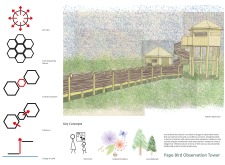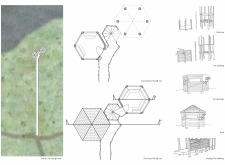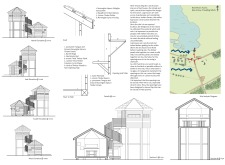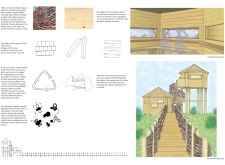5 key facts about this project
### Project Overview
The Pape Bird Observation Tower is located in Latvia, strategically positioned to enhance interaction with the surrounding natural landscape while maintaining accessibility. The design integrates aspects of the local environment and architectural traditions, aiming to offer an engaging and educational experience for visitors interested in birdwatching and ecological observation.
### Spatial Strategy and User Interaction
The design features a tiered structure characterized by hexagonal forms, inspired by natural patterns such as those found in beehives. The central circulation system facilitates smooth visitor movement throughout the tower, allowing for an immersive experience that minimizes disturbance to local bird species. Multiple entry points ensure inclusivity and enhance visitor engagement with the observation activities. Each level of the structure provides varying panoramic views of the wetlands and habitats, enriching the birdwatching experience through thoughtful spatial arrangement.
### Material Selection and Sustainability
Sustainability is a key focus of the design, with careful consideration given to material choices. Norwegian spruce is predominantly used for shingles, panels, beams, and columns due to its durability and climate resistance, making it suitable for outdoor applications. Willow is incorporated into habitat-friendly design elements such as woven screens, which contribute to the site's biodiversity. The use of plywood in less exposed areas reflects a balance between lightweight properties and workability. All materials are locally sourced to reduce the project's carbon footprint, aligning with ecological design principles and enhancing environmental stewardship.






















































